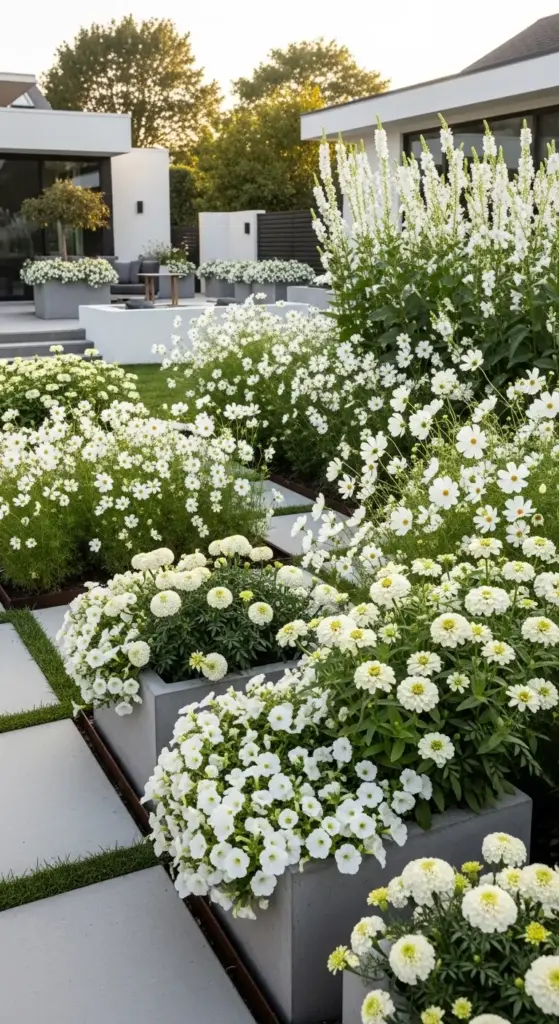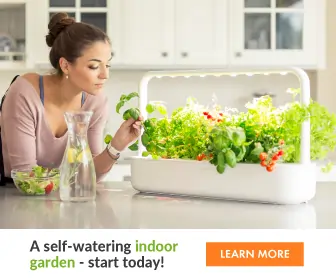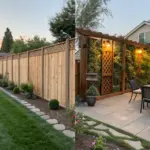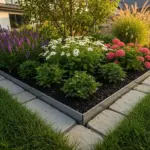2. Modern Minimalist Monochromatic Display

I used to think monochromatic gardens were boring. Then I saw my neighbor’s all-white garden at sunset and literally stopped dead in my tracks.
Sometimes less really is more.
Choosing Your Signature Color Like a Pro
Here’s what nobody tells you about monochromatic garden design – picking your color is the make-or-break decision. I learned this after my first attempt with yellow flowers looked like a highlighter exploded in my yard.
White gardens are the easiest to pull off and photograph beautifully. They glow at dusk and look sophisticated year-round.
Purple schemes create drama but can feel heavy if you’re not careful. I balance deep purples with lighter lavender tones to keep things interesting.
Pink palettes work surprisingly well for modern looks when you stick to cool pinks rather than hot magenta shades. Think blush, not bubblegum.
The key is choosing 3-4 shades within your color family. Pure monochrome can look flat, but subtle variations create depth without breaking your theme.
White Flower Powerhouses That Actually Work
My white flower garden took three seasons to perfect. Here are the varieties that never let me down.
White cosmos are absolute workhorses – they bloom from June until frost and self-seed perfectly. I plant them once and they come back stronger every year.
White zinnias give you that crisp, clean look all summer long. The ‘State Fair Mix’ variety produces huge 4-inch blooms that photograph like dreams.
Nicotiana (flowering tobacco) adds height and evening fragrance. The white varieties can reach 4 feet tall and create stunning vertical elements.
White marigolds might sound weird, but they’re game-changers. ‘Vanilla’ marigolds bloom continuously and handle heat better than most white flowers.
For perennials, white peonies, white iris, and white daylilies give you structure that comes back every year. Plant once, enjoy forever.
Purple Paradise Plants
Purple was my second monochromatic attempt, and honestly, it’s become my favorite. Purple flower gardens have this moody sophistication that’s hard to beat.
Salvia in deep purple shades blooms all season and attracts butterflies like crazy. ‘Victoria Blue’ is technically purple-blue but reads as pure purple in the garden.
Purple petunias cascade beautifully from containers and fill in gaps between larger plants. They’re heat-tolerant and bloom until frost hits.
Lavender is obvious but essential. It gives you that silvery foliage contrast while staying true to your purple theme.
Purple asters extend your season into fall when most other flowers are done. They’re native in most areas and practically maintenance-free.
Contemporary Planting Techniques That Actually Look Modern
Traditional cottage garden planting won’t work for minimalist garden design. I had to completely rethink my approach.
Mass plantings are your secret weapon. Instead of mixing different varieties, plant large swaths of the same flower. I use groups of 15-25 plants minimum.
Geometric patterns create that contemporary edge. I plant in rectangles, circles, or straight lines rather than the curved, flowing shapes of traditional gardens.
Repetition ties everything together. I repeat the same plant combination every 6-8 feet along my borders. It looks intentional rather than random.
Negative space is just as important as planted areas. Leave gaps between plant groupings – it gives your eye places to rest.
Modern Planters That Don’t Cost a Fortune
The right containers can make or break your modern garden aesthetic. I learned this after spending way too much on trendy planters that looked cheap after one season.
Concrete planters are surprisingly affordable if you make them yourself. I use large plastic pots as molds and basic concrete mix. Each planter costs about$15 to make.
Galvanized steel containers have that industrial look that screams modern. Tractor Supply stores sell them for way less than garden centers.
Fiber cement planters look like expensive concrete but weigh half as much. They’re perfect for balconies or areas where weight matters.
Keep shapes simple – rectangles, cylinders, and cubes work best. Avoid anything with decorative details or fancy textures.
Clean-Lined Garden Accessories
Minimalist garden design means every accessory needs to earn its place. I used to clutter my space with too many “cute” garden decorations.
Steel edging creates crisp lines between planted areas and pathways. It’s more expensive than plastic but lasts forever and looks professional.
Simple water features add movement without visual chaos. A single spout fountain or rectangular water basin works better than elaborate tiered fountains.
Modern garden lighting extends your garden’s impact into evening hours. I use simple LED spotlights to uplight key plants rather than string lights or decorative fixtures.
Geometric stepping stones in concrete or natural stone keep pathways clean and purposeful. Square or rectangular shapes work better than irregular flagstone.
Seasonal Rotation Strategies
Here’s where monochromatic gardens get tricky – maintaining interest across all seasons without breaking your color scheme.
Spring bulbs in your chosen color get things started. I plant 300+ white tulips and daffodils for massive early impact.
Summer annuals carry the show through the hottest months. I replant containers every 6-8 weeks with fresh flowers to keep things looking perfect.
Fall transitions require planning ahead. I start purple mums and white asters from seed in July for September planting.
Winter structure comes from evergreen plants and architectural elements. White-barked birch trees or purple-leafed heuchera keep your theme going year-round.
Photography Tips for Social Media Success
My minimalist garden photographs better than any garden I’ve ever had. The simple color palette makes every shot look professional.
Golden hour lighting is crucial for monochromatic gardens. The warm light prevents white flowers from looking washed out and makes purple flowers glow.
Negative space in your photos is just as important as in your garden design. Don’t fill every inch of the frame – let your flowers breathe.
Close-up details show off the subtle variations in your color palette. Macro shots of white petunia centers or purple salvia spikes get tons of engagement.
Geometric compositions work better than random snapshots. Use your phone’s grid lines to create balanced, intentional-looking photos.
Black and white filters can actually enhance monochromatic gardens by emphasizing texture and form over color. Try it on your purple garden photos – the results are stunning.
The biggest surprise about monochromatic gardening? It’s actually more challenging than mixed-color gardens. You can’t rely on color contrast to create interest, so every plant choice matters more.
But when you get it right, the impact is incredible. My white garden stops traffic, and my purple border photographs like something from a design magazine.
Ready to maximize your growing space and create a living work of art on your walls? Click “next” to discover how vertical living wall flower showcases can transform even the tiniest spaces into blooming masterpieces! 🌸









GIPHY App Key not set. Please check settings